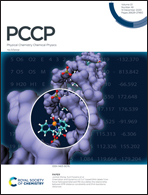Exploring the folding process of human βB2-crystallin using multiscale molecular dynamics and the Markov state model†
Abstract
Adequate knowledge of protein conformations is crucial for understanding their function and their association properties with other proteins. The cataract disease is correlated with conformational changes in key proteins called crystallins. These changes are due to mutations or post-translational modifications that may lead to protein unfolding, and thus the formation of aggregate states. Human βB2-crystallin (HβB2C) is found in high proportion in the eye lens, and its mutations are related to some cataracts. HβB2C also associates into dimers, tetramers, and other higher-order supramolecular complexes. However, it is the only protein of the βγ-crystallin family that has been found in an extended conformation. Therefore, we hypothesize that the extended conformation is not energetically favourable and that HβB2C may adopt a closed (completely folded) conformation, similar to the other members of the βγ-crystallin family. To corroborate this hypothesis, we performed extensive molecular dynamics simulations of HβB2C in its monomeric and dimeric conformations, using all-atom and coarse-grained scales. We employed Markov state model (MSM) analysis to characterize the conformational and kinetically relevant states in the folding process of monomeric HβB2C. The MSM analysis clearly shows that HβB2C adopts a completely folded structure, and this conformation is the most kinetically and energetically favourable one. In contrast, the extended conformations are kinetically unstable and energetically unfavourable. Our MSM analysis also reveals a key metastable state, which is particularly interesting because it is from this state that the folded state is reached. The folded state is stabilized by the formation of two salt bridges between the residue-pairs E74–R187 and R97–E166 and the two hydrophobic residue-pairs V59–L164 and V72–V151. Furthermore, free energy surface (FES) analysis revealed that the HβB2C dimer with both monomers in a closed conformation (face-en-face dimer) is energetically more stable than the domain-swapped dimer (crystallographic structure). The results presented in this report shed light on the molecular details of the folding mechanism of HβB2C in an aqueous environment and may contribute to interpreting different experimental findings. Finally, a detailed knowledge of HβB2C folding may be key to the rational design of potential molecules to treat cataract disease.

- This article is part of the themed collection: 2020 PCCP HOT Articles


 Please wait while we load your content...
Please wait while we load your content...